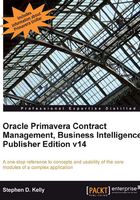
Types of information
Communication on a project needs to be reviewed from many perspectives. Many people look at PCM as simply a template creation tool. It is so much more than that. To see these benefits we need to analyze the information related to a project. Let's look at project communication in the following way:
- Data elements (metadata)
- Document template (collection of data elements placed on a form)
- Supporting information (attachment files)
The data elements are the fields of information that are captured for management, analysis, and reporting purposes. These elements can be captured from information received into your organization for a project or information being sent from your organization regarding a project. PCM organizes this information into one of the many modules. Each module within PCM is designed with specific requirements and business rules in mind. Following are examples of types of data elements that are used by these modules:
- Date received
- Date response is required
- Who is responsible
- Title
- Notes or remarks
- Monetary information
- Specific query or question
- Impact to project
The actual document or template is in the printed form or PDF of the metadata in a professional, organized, and understandable output. Following is an example of such a printout using the data entered into the fields of the RFI module in PCM:

This part of the communication is important for the receiving party to understand what may be required as a result of this communication. Consistency of this output is required for a consistent method of communication for the organization. Many organizations do not require a consistent method of communication but allow project managers to create their own methods. This method of management does not portray a consistent, organized methodology for project communication within their organization. In a perfect world, I suppose, there would be no need for printed or PDF templates as all the parties would have their own access to the data and be able to approve or comment on the data online. This would be the utopian world of collaboration where all parties access the same data and live happily ever after. To date I have not seen a tool where this is effectively accomplished; true collaboration for the most part is a myth in this author's opinion, as every party is looking out for their best interests. There are many books and articles written on the subject of collaboration. Looking at the output from a project, these are some of the forms that can be produced.
- Contract
- Purchase Order
- Request for Information
- Notice of Noncompliance
- Memo
- Request for Proposal
- Change Order
- Requisition for Payment
These are just a few of the different types of templates that would be sent or received on a project. Included with these templates may be supporting information such as drawings, spreadsheets, pictures, and others that need to be attached to that record. These would be the supporting documents to the record that holds the data fields.
Since PCM was designed with the construction project in mind, these modules are designed for construction related documents. However, PCM has also been configured for other vertical markets and types of organizations. If your organization is deciding whether to use PCM and is not construction related, do not just throw out this tool as an option. There are many non-construction related organizations that use PCM successfully such as IT, finance, research, and many others.